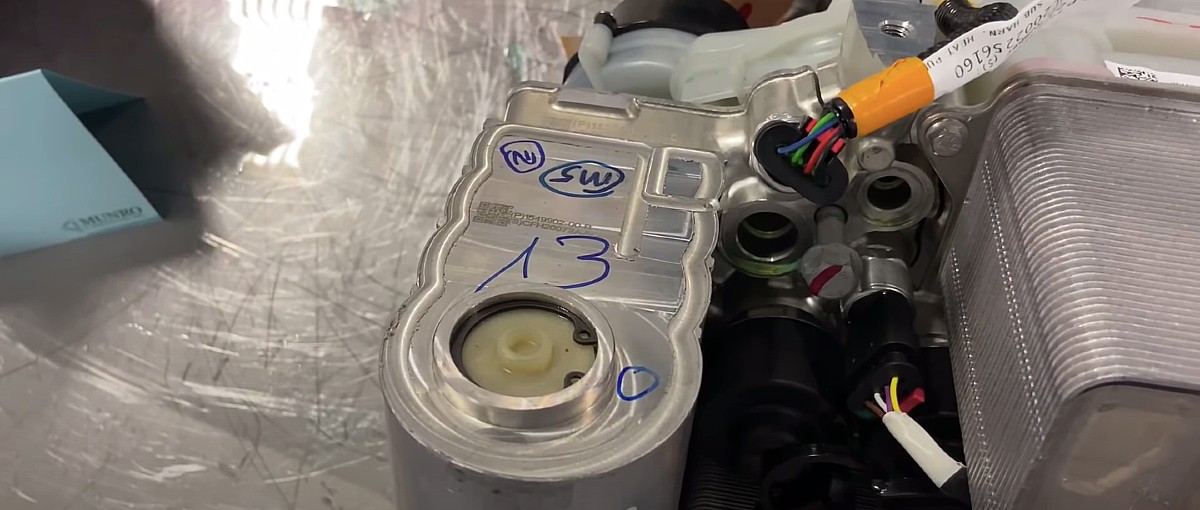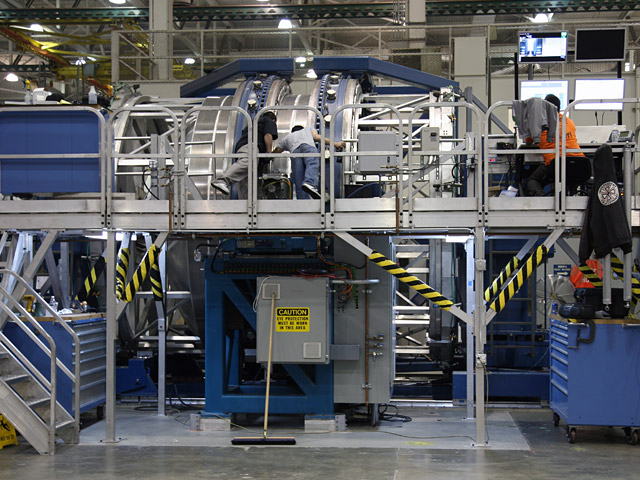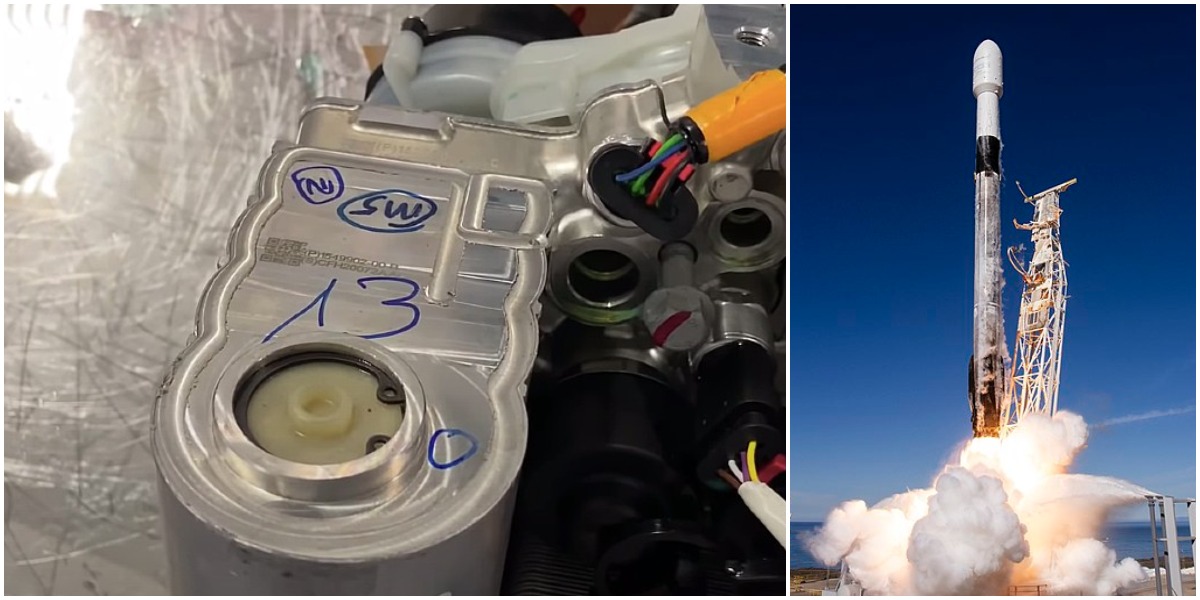A recent episode of Sandy Munro’s Tesla Model Y teardown series has revealed that the electric car company utilized friction stir welding (FSW) for the crossover’s thermal management system. The welding technique is commonly used among aerospace companies, like SpaceX, as a way to maintain the strength of aluminum parts while securing a reliable bond between pieces.
Munro’s analysis of the Octovalve coolant system revealed Tesla’s techniques for the revised thermal management portion of the Model Y. Munro discovered the Octovalve on April 4 after digging into the Model Y’s internal build. The new coolant assembly seemed to be a revised version of the Model 3’s “Superbottle,” which served as the heart of the sedan’s thermal management system.
A car’s thermal management apparatus is responsible for controlling and maintaining proper temperatures in critical portions of the vehicle. In the case of the Model Y, the Octovalve is responsible for motor, battery, and cabin cooling, according to Munro. The Detroit auto veteran said that typically, these systems should not be cooling the cabin if they are controlling battery or motor temperature. The thermal management system in the Model Y seems to be controlling the cabin, the battery, the electronics, and the motor nonetheless.

The Octovalve seems to be a state-of-the-art system as it uses, “some clever little ball valves that open and close to make sure that everything’s getting heated or everything’s being cooled to where it needs to be,” Munro said.
With the assembly overlooking the temperature for these many parts of the vehicle, the system is subjected to drastic and sharp temperature changes. Over time, the difference between heat and cold can begin to weaken portions of the car part, especially if it was exposed to excessive temperatures during manufacturing. This is where some SpaceX-grade solutions come into play.
Tesla chose to utilize friction stir welding for its aluminum portions of the coolant assembly. “This is a cool way of putting two parts of aluminum together, some other materials as well, but aluminum is kind of the most suited for it. And in essence, what happens is you have a stylus that spins around very very quickly. It pokes through the two pieces of metal that you want to friction stir weld. Then, it goes around the outside edge, and what it does is it uses the plastic state or thixotropic state of the aluminum to bind it together,” Munro said.
Simply put, the process allows aluminum to reach a temperature that allows two pieces of metal to come together with a strong bond, but it never turns the metal into a soft, liquid-like state. “It’s like soft butter, butter that you could see is firm, but you could cut it with a knife.”
The advantage of using this process is that the heat from the welding process only applies to the outer edges of the metal. The additional material that is not bonded to anything does not see the heat and is not weakened by the welding process. Stir welding is also time effective as it can be completed in a short period, but it is a careful process that does not apply unneeded stress upon the rest of the assembly.

SpaceX uses friction stir welding for its rockets, as it increases strength by exposing only the bonded portions of two pieces of metal to each other. Friction stir welding was used by SpaceX back in 2008 when the company was combining barrel sections of the Falcon 9’s second stage. “The FSW joins metal without flames, sparking, inert gasses, or fumes, and produces a far superior weld in aluminum-lithium alloys as compared to traditional methods,” SpaceX said in a news update.
In the spirit of humor, Tesla and Elon Musk saw the Octovalve as a perfect opportunity to not only improve the performance of the vehicle temperature regulation system but also as an appropriate time to sprinkle in some additional humor in the form of an Easter Egg. The Model 3 donned a cape-wearing bottle-figured superhero for its “Superbottle” system, while the Model Y includes a snowflake-stamped Octopus as an Easter Egg.
Tesla has increased the effectiveness of its thermal management with the introduction of the Model Y’s Octovalve system. Elon Musk stated that it was some of the best engineering he had ever seen. The welding process could increase the longevity of the machine through its lack of exposure to excessive heat and stress during manufacturing.
Watch Munro’s video on the Model Y’s Octovalve welding below.
Elon Musk
Why Tesla’s Q3 could be one of its biggest quarters in history
Tesla could stand to benefit from the removal of the $7,500 EV tax credit at the end of Q3.

Tesla has gotten off to a slow start in 2025, as the first half of the year has not been one to remember from a delivery perspective.
However, Q3 could end up being one of the best the company has had in history, with the United States potentially being a major contributor to what might reverse a slow start to the year.
Earlier today, the United States’ House of Representatives officially passed President Trump’s “Big Beautiful Bill,” after it made its way through the Senate earlier this week. The bill will head to President Trump, as he looks to sign it before his July 4 deadline.
The Bill will effectively bring closure to the $7,500 EV tax credit, which will end on September 30, 2025. This means, over the next three months in the United States, those who are looking to buy an EV will have their last chance to take advantage of the credit. EVs will then be, for most people, $7,500 more expensive, in essence.
The tax credit is available to any single filer who makes under $150,000 per year, $225,000 a year to a head of household, and $300,000 to couples filing jointly.
Ending the tax credit was expected with the Trump administration, as his policies have leaned significantly toward reliance on fossil fuels, ending what he calls an “EV mandate.” He has used this phrase several times in disagreements with Tesla CEO Elon Musk.
Nevertheless, those who have been on the fence about buying a Tesla, or any EV, for that matter, will have some decisions to make in the next three months. While all companies will stand to benefit from this time crunch, Tesla could be the true winner because of its sheer volume.
If things are done correctly, meaning if Tesla can also offer incentives like 0% APR, special pricing on leasing or financing, or other advantages (like free Red, White, and Blue for a short period of time in celebration of Independence Day), it could see some real volume in sales this quarter.
You can now buy a Tesla in Red, White, and Blue for free until July 14 https://t.co/iAwhaRFOH0
— TESLARATI (@Teslarati) July 3, 2025
Tesla is just a shade under 721,000 deliveries for the year, so it’s on pace for roughly 1.4 million for 2025. This would be a decrease from the 1.8 million cars it delivered in each of the last two years. Traditionally, the second half of the year has produced Tesla’s strongest quarters. Its top three quarters in terms of deliveries are Q4 2024 with 495,570 vehicles, Q4 2023 with 484,507 vehicles, and Q3 2024 with 462,890 vehicles.
Elon Musk
Tesla Full Self-Driving testing continues European expansion: here’s where
Tesla has launched Full Self-Driving testing in a fifth European country ahead of its launch.

Tesla Full Self-Driving is being tested in several countries across Europe as the company prepares to launch its driver assistance suite on the continent.
The company is still working through the regulatory hurdles with the European Union. They are plentiful and difficult to navigate, but Tesla is still making progress as its testing of FSD continues to expand.
Today, it officially began testing in a new country, as more regions open their doors to Tesla. Many owners and potential customers in Europe are awaiting its launch.
On Thursday, Tesla officially confirmed that Full Self-Driving testing is underway in Spain, as the company shared an extensive video of a trip through the streets of Madrid:
Como pez en el agua …
FSD Supervised testing in Madrid, Spain
Pending regulatory approval pic.twitter.com/txTgoWseuA
— Tesla Europe & Middle East (@teslaeurope) July 3, 2025
The launch of Full Self-Driving testing in Spain marks the fifth country in which Tesla has started assessing the suite’s performance in the European market.
Across the past several months, Tesla has been expanding the scope of countries where Full Self-Driving is being tested. It has already made it to Italy, France, the Netherlands, and Germany previously.
Tesla has already filed applications to have Full Self-Driving (Supervised) launched across the European Union, but CEO Elon Musk has indicated that this particular step has been the delay in the official launch of the suite thus far.
In mid-June, Musk revealed the frustrations Tesla has felt during its efforts to launch its Full Self-Driving (Supervised) suite in Europe, stating that the holdup can be attributed to authorities in various countries, as well as the EU as a whole:
Tesla Full Self-Driving’s European launch frustrations revealed by Elon Musk
“Waiting for Dutch authorities and then the EU to approve. Very frustrating and hurts the safety of people in Europe, as driving with advanced Autopilot on results in four times fewer injuries! Please ask your governing authorities to accelerate making Tesla safer in Europe.”
Waiting for Dutch authorities and then the EU to approve.
Very frustrating and hurts the safety of people in Europe, as driving with advanced Autopilot on results in four times fewer injuries!
Please ask your governing authorities to accelerate making Tesla safer in Europe. https://t.co/QIYCXhhaQp
— Elon Musk (@elonmusk) June 11, 2025
Tesla said last year that it planned to launch Full Self-Driving in Europe in 2025.
Elon Musk
xAI’s Memphis data center receives air permit despite community criticism
xAI welcomed the development in a post on its official xAI Memphis account on X.

Elon Musk’s artificial intelligence startup xAI has secured an air permit from Memphis health officials for its data center project, despite critics’ opposition and pending legal action. The Shelby County Health Department approved the permit this week, allowing xAI to operate 15 mobile gas turbines at its facility.
Air permit granted
The air permit comes after months of protests from Memphis residents and environmental justice advocates, who alleged that xAI violated the Clean Air Act by operating gas turbines without prior approval, as per a report from WIRED.
The Southern Environmental Law Center (SELC) and the NAACP has claimed that xAI installed dozens of gas turbines at its new data campus without acquiring the mandatory Prevention of Significant Deterioration (PSD) permit required for large-scale emission sources.
Local officials previously stated the turbines were considered “temporary” and thus not subject to stricter permitting. xAI applied for an air permit in January 2025, and in June, Memphis Mayor Paul Young acknowledged that the company was operating 21 turbines. SELC, however, has claimed that aerial footage shows the number may be as high as 35.
Critics are not giving up
Civil rights groups have stated that they intend to move forward with legal action. “xAI’s decision to install and operate dozens of polluting gas turbines without any permits or public oversight is a clear violation of the Clean Air Act,” said Patrick Anderson, senior attorney at SELC.
“Over the last year, these turbines have pumped out pollution that threatens the health of Memphis families. This notice paves the way for a lawsuit that can hold xAI accountable for its unlawful refusal to get permits for its gas turbines,” he added.
Sharon Wilson, a certified optical gas imaging thermographer, also described the emissions cloud in Memphis as notable. “I expected to see the typical power plant type of pollution that I see. What I saw was way worse than what I expected,” she said.
-

 Elon Musk3 days ago
Elon Musk3 days agoTesla investors will be shocked by Jim Cramer’s latest assessment
-

 News1 week ago
News1 week agoTesla Robotaxi’s biggest challenge seems to be this one thing
-

 News2 weeks ago
News2 weeks agoTexas lawmakers urge Tesla to delay Austin robotaxi launch to September
-

 Elon Musk2 weeks ago
Elon Musk2 weeks agoFirst Look at Tesla’s Robotaxi App: features, design, and more
-

 Elon Musk2 weeks ago
Elon Musk2 weeks agoxAI’s Grok 3 partners with Oracle Cloud for corporate AI innovation
-

 News2 weeks ago
News2 weeks agoWatch Tesla’s first driverless public Robotaxi rides in Texas
-

 News2 weeks ago
News2 weeks agoSpaceX and Elon Musk share insights on Starship Ship 36’s RUD
-

 News2 weeks ago
News2 weeks agoTesla has started rolling out initial round of Robotaxi invites















